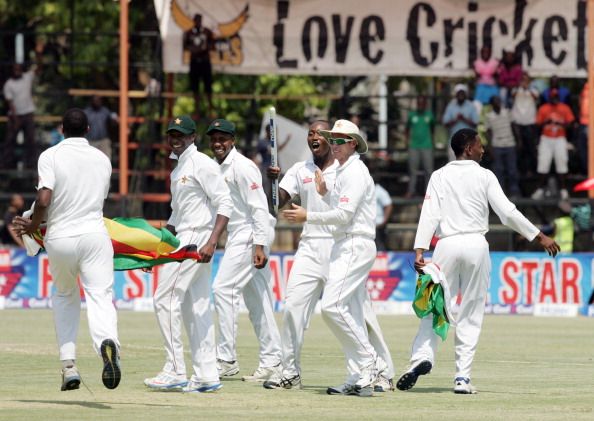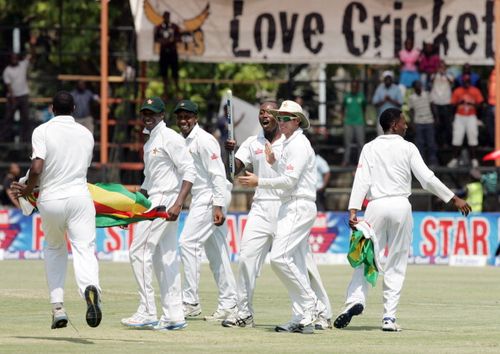
What next for Pakistan cricket?
For a team which is mercurial, a Test loss to a minnow side may not have been a surprising event at all for its fans.
As soon as Rahat Ali was run out at the non-striker’s end and Zimbabwe started celebrating at the end of the second Test at Harare, the question erupted in every Pakistan cricket fan’s mind – what next for Pakistan?

Zimbabwe players celebrate victory over Pakistan on September 14, 2013 during the fifth day of the second Test against at the Harare Sports Club. (JEKESAI NJIKIZANA/AFP/Getty Images)
The loss was shambolic in a sense that Zimbabwe didn’t even feature in the ICC Test Rankings before the start of the match, and Pakistan were ranked number fourth, and to make matters worse, Pakistan had fielded its full strength Test side. This was Pakistan’s fourth Test defeat in five matches this year. Even a drawn Test would have salvaged some pride.
Now, after all the humiliation, Pakistan’s next Test assignment is against South Africa in UAE (United Arab Emirates), a makeshift home venue for them. The conditions are considerably different than African venues where Pakistan have played all of their Test matches this year.
In UAE, flat and spin-friendly tracks are expected, so that Pakistan get a home advantage. The advantage is limited to the Indian subcontinent only. Batsmen who looked technically poor on African pitches will now perform astonishingly well because they are “flat track bullies”.
No doubt, top-notch Asian batsmen have suffered in alien conditions like Australia, South Africa etc., but these players would adapt themselves as quickly as possible.
Pakistan’s young brigade, which includes Azhar Ali, Mohammad Hafeez and Asad Shafiq, occupy important batting positions and featured regularly in Tests this year.
One doesn’t need a calculator to find out that the trio average 21.8, 10.2 and 24.2 respectively in 10 Test innings this year. Among these three, Asad Shafiq is the lone centurion and also has a half-century to his credit, while Azhar Ali has only two half-centuries and Mohammad Hafeez has failed to score any innings of note so far.
In a team where three mainstay batsmen average scantily, success is a distant dream. These are the new breed of batsmen in Pakistan, and the figures clearly reveal their underachievement. Despite regular failures and slip-ups in their batting technique, the trio have kept making it to the playing XI. It seems as if they are the last of the species of batsmen left in Pakistan.
Mohammad Hafeez is ideally and essentially suited for limited-over versions of the game. Going by his current form, keeping him in a Test side is not the wisest of decisions.
Azhar Ali, considered as a replacement for Mohammad Yousuf, comes nowhere close to matching the latter’s abilities, and at times overextends his innings with no impact. Make Azhar Ali bat on a bowler assisted track and he won’t waste much of his time, simply because he won’t last long.
Asad Shafiq, on the other hand, needs to work on his shot selection; maybe he requires only one more go with promotion up the order.
Things in Pakistan cricket have always been unpredictable, and that reflects in the way they play. Pakistan should shun the approach of picking players on their face value; rather, form should be made the basis of selection.
This is high time for Pakistan to set things in order. There is a desperate need to develop a pool of talented players and strengthen the bench, and that’s only possible by introducing raw talent, rather than sticking to the same defunct lot.